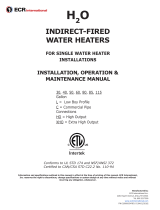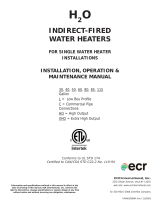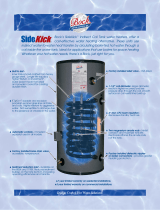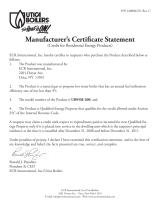
8
Minimum Clearance from Combustible Surfaces:
Bottom -------------------------------- 0”
Left, Right, Rear Sides --------------- 1”
Front ---------------------------------- 1”
Top ------------------------------------ 6”
Minimum Clearance for Service:
Bottom -------------------------------- 0”
Left, Right, Rear Sides --------------- 3”
Front ---------------------------------- 30”
Top ------------------------------------ 6”
3.
Additional recommended components
A. Shut-off valves. Allows the isolation of the
storage tank from the boiler system during
service.
B. Unions. Allows for easy locating or removal.
C. Vacuum breaker. Protects the storage tank from
collapse if a hot tank is valved off to service other
components in the system.
D. Thermal expansion tank. If the storage tank is
installed in a closed water supply system, such as
a system having a back ow preventer in the cold
water supply line, the installation of a thermal
expansion tank is required.
4.
Water Quality
Improper water quality will reduce the expected life of
the storage tank. Hard water, sediment, high or low
Ph, and high levels of chlorides in the domestic water
should be avoided. High or low Ph and/or high chloride
concentrations will cause corrosion and eventually fail. A
lter is strongly recommended where sediment is present
in the water. A water softening system is recommended
for areas with hard water.
In an area where the water quality is not known, a water
quality test should be performed.
WARNING:
Do not operate storage tanks in areas where the
Ph is above 8.0 or below 6.0, and/or with chloride
concentrations greater than 80 parts per million (ppm).
ECR’s standard warranty does not cover problems caused
by improper water Ph or excessive levels of chlorides.
Front View Top View
Vacuum Relief
Temperature and
Pressure Relief Valve
Drain Pan
Drain Valve
Drain
5.
Piping
A. Drain the domestic water system.
Shut off the cold water supply at the main shutoff
valve.
Open one or more faucets to relieve the pressure.
Open the system drain, leaving the faucets open.
B. Position the storage tank in the nal location.
C. Connect the cold water supply piping.
Install piping on to cold inlet connection. Connect
to cold water supply connection using a union, a
heat trap, a shut-off valve, an expansion tank
(where required), a back ow preventer (where
required).
"The storage tank should be installed as close to the
boiler as is practical for easy access for service. The
unit is designed for installation on combustible ooring
and in alcoves, closets, etc."





















